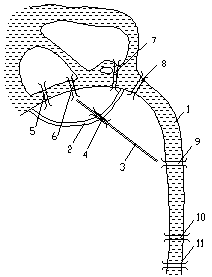BRIDGES OF ST PETERSBURG
5.1 Have you ever been to St Petersburg? If so, try to complement the text with your own information. If not, try to enhance your professional range of knowledge
Tsar Peter the Great wanted to develop his marine and merchant fleets, so he restricted bridging his young town. Nevertheless, there were some timber and floating bridges because the Neva River, being between 350 and 650 m wide, flew 13 km within the city limits, and the city itself sprawled out over the numerous islets of the Neva River Delta. As the city was badly in need of bridges, the first floating bridge appeared in 1727. Like other earlier temporary bridges, it was made of rows of anchored barges tied together, which obstructed free shipping. Strong winds blew in from the sea, rose the water level in the river and crashed the barges or pass them away.
A flourishing age of Russian bridge engineering began in 1762 with the establishment of the Bridge and Road Department. More than three hundred bridges appeared across the rivers and canals including timber, masonry, floating and cast iron structures. St Petersburg earned the reputation of one of the most beautiful cities in the world. The Hermitage Bridge, the Winter Bridge and the Prachechny Bridge were reputed to be among the world’s finest structures. At present, there are 400 bridges in the city, and together with those in the suburbs, the figure is almost 800. Each bridge has its own individual appearance, but taken together they give the impression of one harmonious entity. Some, like the Liteiny Bridge is famous for their wrought-iron bridge railings; others are world-famous for their sculptural groups. The most attractive bridges are in the parks of Tsarskoye Selo (fig. 5.2d), across the Fountanka River and the Griboedov Canal (fig 5.2c).
Some of the bridges over the canals are so narrow that only two persons can walk abreast. The medieval-looking three-span bridges with massive stone towers appeared in the 18th century. Presently towers decorate only the Lomonosov and the Old-Kalinkin Bridges. Modern city planners have to rebuild and broaden the rest of them. Some suspension bridges, built between 1820 and 1840, including the graceful Lion (L’vinyi) Bridge, Pochtamptsky Bridge and Bankovsky Bridge, have survived. The latter is a footbridge adorned with gilt winged lions – griffins. The supporting chains come out of the animals’ jaws making the bridge unique (fig 5.2c).

Figure 5.1 St Petersburg Bridges
1 – the Neva River; 2 – the Fountanka River; 3 – Nevsky Prospect;
4 – the Anichkov Bridge; 5 – the Blagoveshchensky (Lieutenant Schmidt) Bridge;
6 – the Palace Bridge; 7 – the Trinity (Kirovsky) Bridge; 8 – the Liteiny Bridge;
9 – the Volodarsky Bridge; 10 – the Alexander Nevsky Bridge;
11 – the Obukhovsky Bridge
The state takes under its protection about thirty St Petersburg bridges.The Anichkov Bridge across the Fontanka River (fig. 5.1; 5.2a), being part of our national heritage, is one of them. In 1715, the Admiralty engineer battalion under the command of M. Anichkov built a wooden three-span drawbridge about six metres wide on a pile foundation. In 1841, the old structure turned into an arch masonry bridge, as wide as Nevsky Avenue with four towers at the corners decorated with sculptures by Pyotr Klodt. The sculptural group represents a youngster thrown to the ground, then rising on his knee while trying to tame a reared up horse. At last, the animal comes under control, as the youngster becomes steady on his legs, and finally the horse obeys the youngster’s will.

| 
|
| a – the Anichkov Bridge | b – the Hermitage Bridge |

| 
|
| c – the Bankovsky Bridge | d – the Marble Bridge in Tsarskoe Selo |

| 
|
| e – the Blagoveshchensky (Lieutenant Schmidt) Bridge | f – the Trinity (Kirovsky) Bridge |

| 
|
| g – the Palace Bridge | h – the Big Obukhovsky Bridge |
Figure 5.2 Bridges of St Petersburg
Not very far away from the Anichkov Bridge, there is the Egyptian Bridge decorated with four sphinxes. The original suspension bridge had three rows of heavy chains, hanging on two cast-iron gates. Both horse-drawn carriages and pedestrians (fig.5.3a) moved on the structure. Decorated in Egyptian style, the bridge featured hexagonal lanterns, gilded hieroglyphics and ornaments. The bridge approaches, decorated by pink granite with cast-iron sphinxes topped on bridge abutments, made the structure the part of St Petersburg visual environment.

| 
|
| a – The original Egyptian Bridge (1825) | b – The collapse of the Egyptian Bridge (January 20, 1905) |

| 
|
| c – The eternal sphinx | d – The Egyptian Bridge across the Fontanka River (1955) |
Figure 5.3 The Egyptian Bridge
In the winter of 1905 the bridge, which was 80 years old, collapsed. A cavalry squadron crossing the Fontanka River and eleven sleighs moving in the opposite direction fell down into the icy river because metal bridge elements lost their strength under frost. The destructive condition, called metal cold brittleness, caused the disaster (fig. 5.3b). Fifty years later, in 1955, the single span bridge was rebuilt and redecorated. The survived sphinxes lay down to their rightful places (fig. 5.3c). Currently the Egyptian Bridge carries Lermontov Avenue with traffic lanes and banquettes (fig. 5.3d).
Дата добавления: 2015-01-26; просмотров: 2083;
